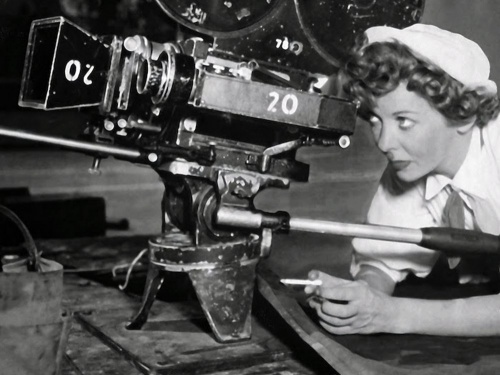Preparing to see Jeanne Dielman...
How best to approach a screening of Jeanne Dielman? If you have seen it before, you will know that it runs at 201 minutes, or 3 hours and 21 minutes. You will know that it tells of a middle aged women living in a one bedroom apartment in Brussels, with her school boy son. Every day he is duly packed off to school, while household matters must be addressed prior to an afternoon call from men who pay for sex. That should not be too much of a spoiler, since the plot is well enough known, and the film dates from 1975.
The most arresting aspect of this film is of course the fact that everything happens in what could be called real time. A potato takes just as long to peel on screen as it does in real life. There is relatively little by way of the familiar compression of action or editing out of what a mainstream entertainment would regard as irrelevant. The action moreover takes place for the most part in a small apartment, but nevertheless an apartment that offers ample opportunity for movement and drama: so many doors to open and close, so many lights to switch on and off, so many objects to move from here to there and there to here. The surfaces being hard, reflect and sustain the sharpness of the sounds that heels make on the uncarpeted floors, water running for the washing up, that pans make on stove tops, and so on.
But there is domestic calm here too: a comfortable parlour, that doubles as the son’s bedroom, the sofa exploding out to become a bed. And the money that makes all this possible, that pays for the food and the rent, that the gentlemen pay Mrs Dielman as they take their leave each afternoon, is kept in a Delft tureen, placed in the centre of the dining table, a centrepiece for the apartment and these lives. The son knows that if he asks nicely he will be given a little extra from the tureen.
That Delft tureen might bring to mind the painting of the Low Countries. The tureen is the product of industry meeting bourgeois appetites. It permits the elegant presentation of soup, the daily staple that Jeanne provides her son. And the painters of the Low Countries that emerged to portray the bourgeois and petit bourgeois lives in an astonishing departure from sacred themes, did so with some affection. They loved doorways as framing devices, not as keyholes, but as markers of the domestic interior, of comfortable private domains. Thresholds are tender transitions from an exterior that maybe impersonal to an interior that is always personal.
And so it is for Jeanne – her excursions require her to be well prepared – lipstick, hair spray, coiffure – all as they should be. Comme il faut. Her preparations for the arrival of the gentlemen callers of course require a similar level of personal attention – the mirrors in this apartment are employed only when an encounter with another is anticipated. They reflect what the outside world will see. In the privacy of the domestic world there is no need for that anxiety. The domestic space is not, if regarded in this light, always a prison, as is easy to assume.
Averted gaze is another characteristic of Jeanne Dielman. Eyes do not meet, eye lines do not connect, there are no reverse angles to suggest anything of that kind of interaction. This is a drastic radicalism in cinema. Akerman herself was very ready to meet the camera’s gaze in La Chambre but here Jeanne is often shot square, framed geometrically, without camera movement to adjust to bodily movement. Jeanne inhabits this frame and does not much seek to leave it. If Jeanne meets another while out and about, her eyes are likely to look down, and of she shares a meal with her son, they sit at right angles to each other. Even when the boy is in bed and Jeanne takes her leave of him, by clever contrivance, they are never face to face as they kiss good night.
This avoidance is a marker of the radicalism of New York – where Akerman soaked up the experimental film making at Anthology Film Archives, a few blocks away from Judson Church, where Yvonne Rainer and others had been pursuing a radical dance agenda. In Rainer’s 1969 statement given out for the The Mind is a Muscle show:
'It is my overall concern to reveal people as they are engaged in various kinds of activities—alone, with each other, with objects—and to weigh the quality of the human body towards that of objects and away from the super-stylization of the dancer.'
Moreover, as she has said of her Trio A:
'Two primary characteristics of the dance are its unmodulated continuity and its imperative involving the gaze. The eyes are always averted from direct confrontation with the audience via independent movement of the head or closure of the eyes or simple casting down of the gaze'.
The energy of these enquires has, it might seem, readily infused itself into the strategies and design of Jeanne Dielman. The delight of this film for me is very much about the discovery of a form of cinema that brings the radicalism of New York into fruitful union with the framed domestic interiors of the Low Countries.
I detect three pivotal moments.
The first is a moment about what is not said, about what does not happen. The son reads his class room exercise, a poem by Baudelaire, The Enemy. It is a poem about the need in later life to foster some sense of order so that there can be a fruitful denial of death. No mention of this sentiment, rather talk of the quality of the boys pronouncing of 'r' sounds (important in Belgium where French vies with Flemish).
Following this, a sentimental ballad plays on the radio. It distract Jeanne from her dutiful writing of a letter. The son knows that it has intruded on his mother’s peace of mind. It has, but Jeanne makes sure they stick to the routine, and the evening constitutional means that the radio is switched off. If only I know what the song was exactly (please post a comment if you know!)
After this, comes an outburst, which for those who have not seen the film, will be described simply as an astonishing and perplexing dialogue between mother and son at bedtime.
All else follows from these moments, the first a question of denial the second a question of perturbation without explanation, the third the beginning of the end.
The film has been much analysed, and analysed brilliantly, but the merit of repeat viewing is a developing awareness of furniture, objects, the pattern of the chores that varies microscopically, revealingly. One grows aware of ‘the quality of the human body towards that of objects and away from… super-stylization’.
Finally, Akerman has talked (an interview in Camera Obscura in 1977) of the fact that it was her own adoring observation of her own mother’s movements and activities in her home, in her private domestic domain, that informed and shaped Jeanne Dielman. The love of her mother certainly emerges for me in this superb and compassionate characterisation, that sidesteps cliché, that brings a genuine radical purpose into perfect realisation, and that (as Ezra Pound might have said) is news that stays news.
Adam Roberts
10 December 2013
Chantal Akerman 3: Jeanne Dielman, 23 Quai du Commerce, 1080 Bruxelles screens on Thursday 12 December at 7pm, as part of the A Nos Amours complete retrospective of the films of Chantal Akerman.
This article is posted in: Articles, Film
Tagged with: Chantal Akerman, Adam Roberts





